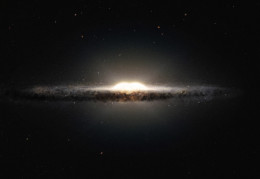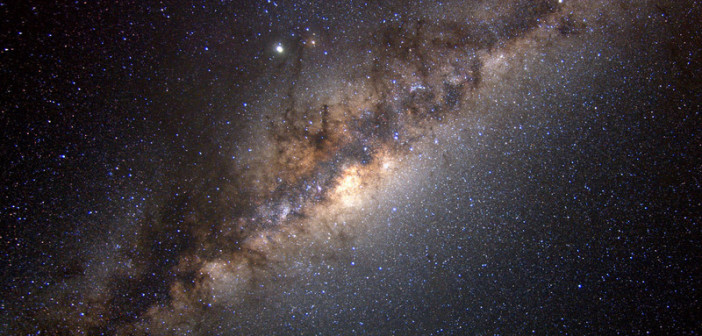The Milky Way’s dense central bulge is a very different environment than the surrounding galactic disk in which we live. Do the differences affect the ability of planets to form in the bulge?
Exploring Galactic Planets
Planet formation is a complex process with many aspects that we don’t yet understand. Do environmental properties like host star metallicity, the density of nearby stars, or the intensity of the ambient radiation field affect the ability of planets to form? To answer these questions, we will ultimately need to search for planets around stars in a large variety of different environments in our galaxy.One way to detect recently formed, distant planets is by gravitational microlensing. In this process, light from a distant source star is bent by a lens star that is briefly located between us and the source. As the Earth moves, this momentary alignment causes a blip in the source’s light curve that we can detect — and planets hosted by the lens star can cause an additional observable bump.

Artist’s impression of the Milky Way galaxy. The central bulge is much denser than the surrounding disk. [ESO/NASA/JPL-Caltech/M. Kornmesser/R. Hurt]
Relative Abundances
Most source stars reside in the galactic bulge, so microlensing events can probe planetary systems at any distance between the Earth and the galactic bulge. This means that planet detections from microlensing could potentially be used to measure the relative abundances of exoplanets in different parts of our galaxy.
A team of scientists led by Matthew Penny, a Sagan postdoctoral fellow at Ohio State University, set out to do just that. The group considered a sample of 31 exoplanetary systems detected by microlensing and asked the following question: are the planet abundances in the galactic bulge and the galactic disk the same?
A Paucity of Planets
To answer this question, Penny and collaborators derived the expected distribution of host distances from a simulated microlensing survey, correcting for dominant selection effects. They then compared the distribution of distances in this model sample to the distribution of distances measured for the actual, observed systems.

Histogram and cumulative distribution (black lines) of distance estimates for microlensing planet hosts. Red lines show the distributions predicted by the model if the disk and bulge abundances were the same. [Penny et al. 2016]
What’s to Blame?
There are a few ways to interpret this result: 1) distance measurements for the sample of planets discovered by microlensing have errors, 2) the model is too simplified; it needs to also include dependence of planet abundance and detection sensitivity on properties like host mass and metallicity, or 3) the galactic bulge actually has fewer planets than the disk.
Penny and collaborators suspect some combination of the first two interpretations is most likely, but an actual paucity of planets in the galactic bulge can’t be ruled out. Performing similar analysis on a larger sample of microlensing planets — expected from upcoming, second-generation microlensing searches — and obtaining more accurate distance measurements will help us to address this puzzle more definitively in the future.
Citation
Matthew T. Penny et al 2016 ApJ 830 150. doi:10.3847/0004-637X/830/2/150

